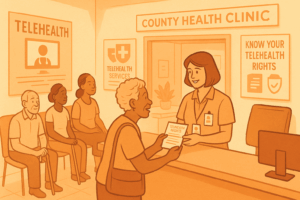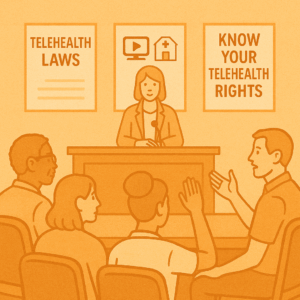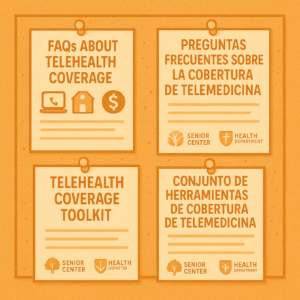Communicating Care: Oregon’s County-Level Strategy to Promote Telehealth Rights and Parity in 2021
 The COVID-19 pandemic triggered a rapid expansion of telehealth services across the United States, with temporary emergency waivers enabling providers and patients to access remote care options at unprecedented levels. But as those waivers neared expiration, Oregon faced a critical question: how could it preserve telehealth access for residents—particularly those in rural and underserved areas—once the public health emergency ended?
The COVID-19 pandemic triggered a rapid expansion of telehealth services across the United States, with temporary emergency waivers enabling providers and patients to access remote care options at unprecedented levels. But as those waivers neared expiration, Oregon faced a critical question: how could it preserve telehealth access for residents—particularly those in rural and underserved areas—once the public health emergency ended?
At the state level, lawmakers advanced Senate Bill 11 and House Bill 2508 to make telehealth parity permanent. These bills aimed to require insurance companies to cover telehealth visits just as they would in-person care, ensuring equal treatment in both cost and access. Yet policy change alone wasn’t enough. While these bills made their way through the legislative process, Oregon’s Department of Consumer and Business Services (DCBS), through its Division of Financial Regulation (DFR), recognized the urgent need to bridge the gap in the meantime.
In response, DFR launched a targeted, county-level communication campaign to ensure Oregonians remained informed of their rights and coverage options under existing emergency provisions through June 30, 2021. By aligning insurer compliance efforts with consumer education, localized outreach, and clear messaging, the campaign served as a stopgap to maintain equitable telehealth access until permanent laws could take hold.
This case study explores how Oregon translated high-level policy intentions into real-world implementation—building trust, reinforcing coverage, and helping residents understand their care options when it mattered most.
The Initiative: Extending Telehealth Access Post-Emergency
Policy Context and Campaign Goals
As the pandemic’s acute phase began to subside, DFR recognized a looming risk: without proactive policy and public awareness, many Oregonians—especially in rural areas—could lose access to telehealth options that had become lifelines. The agency set out to:
- Promote insurer compliance with telehealth parity rules through mid-2021
- Educate consumers on their rights to cost-share parity and service accessibility
- Coordinate with local providers to maintain care continuity
- Gather public feedback to inform longer-term telehealth legislation
While Senate Bill 11 and House Bill 2508 were moving through the legislature to establish permanent parity, DFR’s interim campaign ensured consistent coverage, public clarity, and regional participation.
Communication-Centered Program Activities
1. Goals and Messaging Strategy: Tailoring the Message to Local Realities
At the heart of the campaign was a dual-audience messaging strategy: Oregonians needed to know they could access and afford telehealth care, and insurers needed to be reminded of state-mandated payment parity and expanded access rules.
- Core Messaging Themes:
“Your telehealth visit should be covered just like an in-person appointment.”
“You have a right to coverage parity—check your insurer’s COVID policies.”
“Expanded telehealth coverage lasts through June 30, 2021. Ask your provider or insurer for details.” - Target Audience Segmentation:
- Consumers received simplified messaging through FAQs, hotline numbers, and local bulletins.
- Insurers and providers received technical updates, claims billing guidance, and parity toolkits.
- County-Level Customization:
Messaging was localized based on county-specific provider networks, insurer availability, and broadband access levels. Community health clinics, Coordinated Care Organizations (CCOs), and county health departments shared tailored materials that addressed the local context.
Why It Worked:
- Dual messaging recognized that one-size-fits-all outreach wouldn’t work in a state with vast geographic and service disparities.
- County-specific resource promotion made the campaign feel personal and actionable.
2. Toolkit and Guidance Materials: Creating Infrastructure for Consistency
To support both consumers and insurers, DFR developed a centralized telehealth resource hub through its COVID Consumer Health Insurance web pages.
- Public-Facing Resources:
- Telehealth FAQs explaining what services must be covered and at what cost.
- Insurer-specific listings showing which plans agreed to coverage parity and expanded modes (video, phone, text).
- Step-by-step coverage rights guides, available in English and Spanish.
- Technical and Regulatory Guidance:
- DFR and the Oregon Health Authority issued joint bulletins to insurers requiring:
Payment parity with in-person services;- Inclusion of behavioral and preventive health services
- Acceptance of multiple service delivery modes
- Clarification on telehealth billing codes
- DFR and the Oregon Health Authority issued joint bulletins to insurers requiring:
- Legislative Context:
- These tools built on the foundation laid by Senate Bill 11 and House Bill 2508, which were designed to extend telehealth parity permanently. DFR ensured that legislative discussions were connected to immediate implementation through coordinated messaging.
Why It Worked:
- The hub served as a “one-stop shop” for residents, providers, and carriers alike.
- Tools supported uniform implementation across counties, regardless of provider size or digital capacity.
3. County-Level Implementation Tactics: Engaging Local Messengers
Recognizing that statewide policy needed local trust to work, DFR activated partnerships with county agencies, clinics, and provider associations to deliver messages in the places where people sought help.
- Local Press and Digital Outreach:
Through GovDelivery bulletins (March–May 2021), DFR disseminated messaging to:
- County health departments
- Regional CCOs
- Community health coalitions
- Local media outlets and provider directories
- In response, counties published telehealth rights materials on their own websites, social media, and in community newsletters—often translating them or adapting them to reflect local networks.
- Provider Partner Coordination:
Clinics and CCOs received “telehealth parity toolkits” with:
- Rights posters to display in waiting rooms
- Online banners and PDF inserts for patient portals
- Talking points for front-desk staff and intake personnel
- Public Hearings and Comment Opportunities:
Before finalizing 2021 rate and policy changes, DFR held county-targeted pre-rate hearings where insurers and residents could weigh in. The department also opened online comment platforms through May 2021, inviting public feedback specifically on telehealth access, much of which was used to shape the next legislative phase.
Why It Worked:
- Local providers acted as trusted messengers—ensuring that coverage updates were not just technical announcements but care-related updates from familiar faces.
- Input loops made residents feel heard and provided valuable insight into barriers like inconsistent broadband or confusing insurer documentation.
4. Direct Consumer Support Channels
To ensure that no one was left behind, DFR promoted consumer assistance options across print and digital channels.
- Dedicated Hotline:
Staff were trained to handle telehealth-related questions, guide callers through insurance documents, and assist in filing complaints or coverage appeals. - Community Posting of Hotline Info:
Libraries, senior centers, rural clinics, and community nonprofits were given flyers and posters to display, extending the hotline’s reach beyond those actively seeking help online. - Simplified Language & Multilingual Access:
FAQs and coverage guides were translated and rewritten in plain language, helping residents with low English proficiency or lower health literacy understand their rights.
Why It Worked:
- Centralized hotline support turned policy confusion into action.
- Local presence and multilingual distribution built trust and inclusivity.
- Staff could flag systemic insurer issues, feeding back into enforcement strategy.
 Outcomes and Communication Impact
Outcomes and Communication Impact
1. Telehealth Usage Surge Validated the Strategy
- A 2,800% increase in telehealth claims (March–April 2020 vs. same period in 2019) demonstrated the necessity of expanded access.
- Continued growth through 2021 confirmed that usage was not a temporary pandemic spike—it was a shift in care delivery preferences.
2. Insurer Compliance and Sustained Access
- Most major insurers agreed to reimburse telehealth visits at parity through June 30, 2021.
- The policy foundation, reinforced by DFR’s communication efforts, helped build consensus for permanent parity discussions via SB 11 and HB 2508.
3. Strong Community Feedback and System Trust
- Residents submitted comments through online portals, public hearings, and partner networks.
- County-level partners praised the transparency and usability of DFR’s tools, with some adapting the resources for their own ongoing use.
Takeaways: Lessons from Oregon’s County-Level Telehealth Campaign
- Localized Messaging Builds Trust
Residents trust their community clinics and health departments more than state regulators. By equipping those partners, DFR gained credibility and expanded its reach. - Toolkits Turn Policy Into Practice
Technical bulletins alone aren’t enough. Posters, talking points, and digital inserts help policies show up in the real world. - Feedback Loops Improve Legislation
Online comment forms and local hearings made residents part of the policymaking process—and improved the final outcomes. - Multi-Channel Outreach Ensures Inclusion
Hotlines, translated materials, physical posters, and digital portals reached people across tech comfort levels, age groups, and languages.
Conclusion: Building Sustainable Health Access Through Communication
Oregon’s 2021 telehealth communication campaign proved that effective policy implementation requires more than legal mandates—it requires outreach, listening, and localized engagement. By aligning messaging with local resources, coordinating with county partners, and keeping the public informed through clear, accessible channels, DFR ensured that residents could maintain access to the care they needed during and beyond the pandemic.
As telehealth becomes a permanent part of healthcare delivery, Oregon’s approach offers a national model: don’t just set the policy—communicate it clearly, reinforce it locally, and build the infrastructure to make it last.
Ready to Elevate Your Agency’s Public Communication?
We understand the unique challenges state and local government agencies face—from complex issues to diverse community needs. Our comprehensive approach can help you transform the way you connect with constituents, improve transparency, and highlight the valuable work your agency does every day.
Interested in learning more? Reach out to us today for a consultation. We’d love to discuss how our services can support your goals and help you build lasting trust with the communities you serve.



 Outcomes and Communication Impact
Outcomes and Communication Impact

